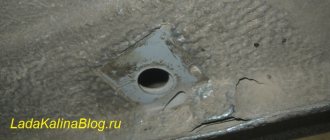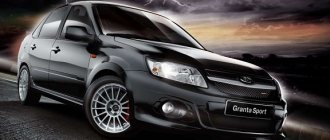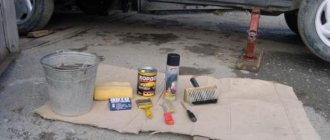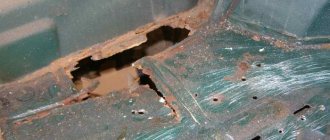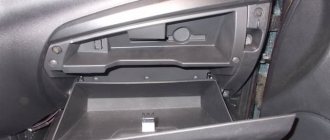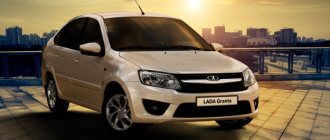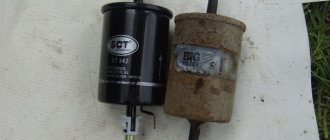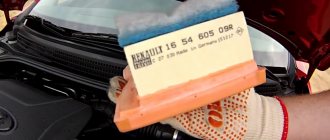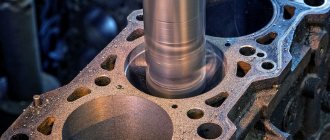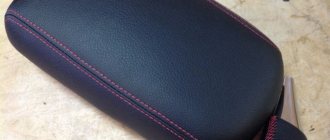Automobile: Lada Granta. Asks: Anonymous. Question: Is it necessary to treat the body or underbody of the Lada Granta?
I have long wanted to ask how to treat the underbody of a Granta sedan? Of course, there is no standard processing. So far I don’t see any problems with corrosion, but I wanted to be on the safe side. Or maybe it makes sense to protect some other details? How exactly and with what to process them is what interests me.
Timely processing and reasons for its need
Lada Granta, anti-corrosion treatment of which has now become an important maintenance element, needs it, since during operation the car constantly encounters factors that cause corrosion. These include:
— Weather conditions that create high humidity and constant contact of the body with water.
— Poor quality of the top coating layer.
As sad as this may sound, the outer layer of the Grant is actually made of cheap materials that are more susceptible to corrosion than high-quality coatings. Anti-corrosion treatment of Lada Granta is a necessity caused by operating conditions.
Work technology, materials used
Anti-corrosion treatment of Lada Granta is carried out in several stages.
- washing;
- drying;
- visual inspection;
- removing rust;
- processing of internal cavities;
- coating of external surfaces of the body;
- assembly.
External processing is carried out on an overpass or from an inspection hole
To carry out the work you need to prepare:
- anticorrosive black "Tektil" - 5 kg;
- aerosol cans of Tektil ML - 4 pcs.;
- brushes of different widths and hardness;
- latex gloves;
- plastic tube;
- metalworking tools;
- solvent.
To work, you will need an inspection pit or overpass with a lift.
Processing details to pay special attention to
Lada Granta, whose factory anticorrosive is only a small part of the necessary measures to protect the body, requires additional protection. Anticorrosive Lada Granta is an event that requires a holistic approach, however, there are places where the Lada Granta body is treated that should be given special attention.
So, for example, anti-corrosion treatment of Lada Granta thresholds is a paramount condition for protecting the car body. Susceptibility to corrosion thresholds is a consequence of the greatest physical impact compared to other parts of the body. Other elements to pay attention to include:
- bottom. It is on this that the protective function falls, which ensures that excess moisture does not penetrate. Even installed protection will not provide a complete guarantee of the absence of corrosion.
- wheel arches. Constant exposure to water and dirt from the wheels does its job.
Myth 3: Only exposed areas of the body rust, which cannot be protected with anticorrosive.
It's not like that at all
Please note that many cars rust along the lower edges of external surfaces and elements. The edges of hoods, doors, trunk lids, the edges of roof panels, the lower edges of fixed rear fenders - these are the first areas to be attacked by corrosion.
Why? It's all about condensed moisture, which inevitably forms in the off-season. During night frosts, the body metal cools to low temperatures and dew falls on it. And not only from the outside, but also from the inside - after all, the air and the moisture contained in it penetrates into all unsealed cavities. And if the dew dries on the outer panels, it does not on the inner panels. Droplets of moisture flow down to the lower edges and collect there, gradually penetrating to the steel through a thin layer of soil. As a result, rust - hydrated iron oxide - breaks out from under the paint. Therefore, first of all, it is necessary to protect the hidden cavities of the body and the joints of metal sheets with anticorrosive agents!
Anticorrosion options
Since the design features of the machine include hidden spaces, it is necessary to divide the funds into:
— means for treating accessible surfaces
— products for treating hard-to-reach surfaces
Products applicable to accessible surfaces contain the following active ingredients:
— liquid plastic — rubber — mastic (bitumen)
Places most susceptible to corrosion are usually treated with oil-containing preparations - they allow you to create a certain film that can remain in place for a long time. Anticorrosive on Grant must withstand all the vagaries of the weather.
For areas where car operation involves frequent encounters with moisture, a product based on paraffin can be used - its use also allows the film to remain on the surface for a long time.
Lada Priora
The next domestic model produced at the Volzhsky Automobile Plant is the Lada Priora. Today it is produced in 4 body variations. The line of models also includes the Priora Coupe - which, however, has not yet gained any popularity among Russians.
Lada Priora
An important parameter of the Priora body, again, is the LCD/c value. It is noteworthy that for the Priora this figure is 12,000 Nm/deg in the sedan version. In other variations, except for the coupe, it is a row lower.
Despite this, there are general indicators for all 3 models, implying body dimensions. Thus, all body types (except coupe) have the same wheelbase, ground clearance and width. As for the length, let us recall that the sedan’s figures are 4350 mm, the hatchback’s are 4,210 mm, and the station wagon’s are 4,340 mm. The heights of the bodies are also different: the sedan is 1420 mm, the hatchback is 1435 mm, and the station wagon is 1508 mm.
Initially, the weak areas of Priora bodies were considered to be the roof, hood and trunk. It is for this reason that experts insist on the mandatory treatment of all internal surfaces of problem areas by the car owner himself with an anticorrosive agent.
Priora body protection against corrosion is provided for 6 years. In practice, this period is determined by: zinc coating of the sills, bottom and arches, as well as the use of low-alloy steel.
Dimensions of Priora
Indeed, practical experience has proven that the Priora body is incredibly resistant to corrosion. If problems start, the first ones at risk are the bumpers, then bubbles form on the paintwork in the winter, and the paint peels off.
The 12 thousand Nm/deg indicator on the Priora sedan is not a large value. Even the VAZ-21106, not to mention foreign cars, has a higher figure. Thus, Priora owners who prefer active driving would do well to strengthen the car’s frame. In particular, strengthening should involve the installation of strut struts and modernization of the SPU on the rear axle.
Self-processing - is it possible?
Since high-quality car processing in specialized services will cost a pretty penny, sophisticated owners, after studying the issues of how to process a Lada Granta video, began to implement the acquired knowledge.
First of all, if you decide to carry out the processing yourself, you must understand that without certain skills and special equipment, the quality of the result will be poor.
You can achieve adequate results only by strictly following the instructions. Thus, do-it-yourself anticorrosive Lada Granta is a matter that requires collecting information, without which it is impossible to take into account all the features and subtleties of the process.
“Lada Kalina II” or “Lada Priora I”: which is better and does it make sense to buy
At first glance, the question sounds like “do you want black or green tea?” On the second one, actually, too. Before the arrival of foreign engineers and managers, VAZ riveted surprisingly identical cars, even if they formally belonged to different classes.
On the secondary market, the second Kalina and the first generation restyled Priora cost almost the same - 314 and 312 thousand rubles, respectively. Offers for them are also almost at the same level - 140-155, but Priora is most often bought and sold. In May, it was checked 22,730 times through avtocod.ru, placing it in second place among all models. “Kalina” ended up in 16th place with 12,997 checks. What is better to buy on the secondary market - Priora or Kalina, let's figure it out.
DIY processing, process
The first thing to do is to thoroughly wash the car and dry it. Moisture will cause the spray to roll off, preventing you from achieving a dense, even coating. Next, we inspect the car. It is necessary to find all places where rust accumulates and clean them. Now we fence off areas that do not need treatment - film or a bag is quite suitable for this.
Important!!! When treating hard-to-reach areas, you will need a powerful sprayer. If you don’t have it, don’t try to apply the products in other ways - they won’t produce results, or they will be uneven, which is the same quality as no treatment.
For high-quality processing, a minimum of two layers are required, each of which must dry (the drying process, depending on the product, lasts from 5 to 13 hours).
Such independent coating, provided it is of high quality, can safely protect your car for 3 years.
Thus, anti-corrosion treatment can not only extend the life of the body of your car, but also do a good job of its noise insulation properties, as well as the strength of the structure as a whole. For guaranteed quality processing, contact professionals. If you decide to act on your own, do not neglect the advice on high-quality anti-corrosion treatment with your own hands.
Lada Kalina or Lada Granta
A large group of engineers worked to create the design for both cars. Each looks modern and looks like a foreign car. Grant's design was created from the very beginning by analogy with Kalina. The engines on both cars are practically no different. Both have improved suspension. The gearbox is also identical.
The metal body of the Grant is very thin. Manufacturers explained this by using a completely different type of metal. But it can bend easily, since it is made of thin metal. They also decided to save money on the plastic bumper. On the new Grant, at first the doors lock and open well, but after some time you will have to make an effort to do this procedure. Kalina has no such defects.
There are also differences in the seats. Granta's are cheap and cannot boast of comfort. Kalina has anatomical seats that follow the shape of the human body; they are more comfortable when sitting. The interior of each car is wide. When driving on gravel, the Granta cannot be called quiet. When a stone hits the body, the sound will be clearly audible. In terms of sound insulation, Kalina, of course, is also not ideal, but it is still much quieter.
To keep the cost of the car lower, Granta was supplied with low-quality plastic. It is very easy to scratch and looks cheap. This is not the case in Kalina. The Granta can reach greater speeds thanks to its aerodynamic properties. However, the difference with Kalina is small. Fuel consumption also does not differ significantly. If you look at the little things, the Granta does not have limit switches on the doors and headlight hydraulic adjustment.
If we consider the Grant, it does not look like Russian cars, but the side doors unite it with the Kalina. In terms of luggage racks, Kalina is inferior to Granta. Due to the increased body length, the Granta's trunk is large, but it looks unaesthetic and closes loudly. However, Granta wins with its dashboard, which does not make sounds, which cannot be said about Kalina. The Granta has one more advantage - a short steering rack. But there was no room left for an ashtray.
The Grant has a Kalina engine, but it has some advantages. With the same number of valves, the engine power of the Grant is greater than that of the Kalina. This is explained by the installed lightweight connecting rod and piston group. In general, Kalina moves slower than Granta. The Granta engine runs without any noise, but Kalina has better plastic casing material.
If we compare the safety of cars, we should note the airbags in Grant, which are not present in Kalina. Given the budget class, this is a big plus for the Grant. Even if we briefly evaluate these two cars, we can say that the Granta is no worse than the Kalina, although it is made on its basis. When comparing the parameters, it can be called even the best. Kalina is more expensive than Grants by about 30 thousand rubles. Grant can be considered an alternative to Kalina.
Granta will be produced, like Kalina, in a hatchback body. If you evaluate from this point of view, Grant looks youthful. Each of the cars is inferior in some ways, but good in some ways and even superior to the other, but at an insignificant level. If we talk about the price category, then it is better to take the Lada Granta.
Reviews of aerosol Movil
Although Movil in aerosol form is less popular than car preservative in cans, it is often used by car owners. Users leave various reviews about this tool, there are both negative and positive comments.
Dmitriy. I would like to express my opinion about the Movil preservative in an aerosol can; I bought the Eltrans product in order to treat the front subframe, which has many hidden cavities. The bottle comes with a nozzle with a straw, so spraying the liquid is very convenient. Movil spreads well over the surface, creates a layer similar to solid oil, but emits a rather pungent odor. I liked that this composition is good for treating hard-to-reach places, I can’t say anything about the effect yet, I don’t seem to have noticed any rust. In general, I liked the bottle, the advantages are ease of use, fairly economical consumption (a liter bottle was enough for the entire subframe), I didn’t find any disadvantages.
Yuri. I bought Movil with a rust converter (manufactured by Astrokhim), and was fooled by the advertising. I don’t know who this chemistry helps, for me personally it’s complete nonsense. The product does not combat corrosion at all; the spray nozzle becomes clogged almost immediately and cannot be cleaned. I threw the can in the trash, I won’t buy anything like it again.
Alexei. After 2 years of using my car, I decided to treat the engine compartment, underbody and fenders with a preservative before winter; for this I bought Movil BBF. I did the processing myself, did everything according to the instructions, it took me three bottles, and the total cost was less than 400 rubles. I have been using car preservative for two years now, there are no salt deposits or traces of rust on the car. I recommend this product because it is inexpensive, easy to apply, and gives the desired effect.
Leonid. I have been working with Movil for a long time, since 1998, only then it was sold in a bottle, and I applied it with a brush. Recently I have been using BBF, although the packaging says that it is an anticorrosive agent for hidden cavities, I treat it on my car 2108 and external surfaces, and carry out preventive maintenance before winter. The opinion about the autopreservative is positive; it works effectively, especially since it costs much less than its foreign analogues.
When using Movil, it should be taken into account that the product does not adhere well to mastic, corrodes rubber parts, and is a fairly toxic substance. And you should not apply an anti-corrosion compound to a rusty metal surface; the metal under the anti-corrosion layer will continue to rot. In general, this product quite effectively protects the car body from premature corrosion and does not allow new rust to appear under the protective coating layer.
The formation of corrosion on a car body can lead not only to the loss of the appearance of the car, but with prolonged exposure to the complete destruction of thin metal over the entire area. If the engine or transmission after a major overhaul, in terms of its main characteristics, practically does not differ from the new state, then eliminating numerous areas of metal rusting can be very difficult, and sometimes even economically impractical.
It is much easier to prevent the destruction of a metal body than to then try to patch through holes using welding or putty. One of the most effective means for preventing the formation of corrosion on a car body is Movil.
What do official representatives of the domestic auto giant say?
At the factory, the metal body panels of the Lada Grant are treated with a zinc layer. The low cost of the model we are considering does not allow such coverage over the entire body area. The most vulnerable areas are subject to protection. This applies to:
- door panels;
- hind wings;
- niches for stern wheels;
- luggage compartment covers;
- protective body screen;
- bottoms;
- rear fender gutters.
This statement gives an understanding of the issue regarding the galvanization of body components of the Lada Grant. In this regard, discussions around the products of the domestic auto industry are heating up with serious force. While fans and owners continue to argue, AvtoVAZ is improving its car production strategy, the list of main priorities of which includes galvanizing body components.
Factory conditions require the application of the following types of coatings:
- thermal galvanizing, which is the most reliable means of processing;
- galvanization, which involves obtaining a zinc layer on body panels formed by an appropriate solution under the influence of an electric current;
- a primer coating that involves the preliminary application of salts containing impurities of manganese, zinc and iron to the metal surface.
3) Dismantling removable parts and plugs
To provide access to some areas of the body, it may be necessary to dismantle some trim elements and plugs for technological holes. In addition, sometimes this is done to avoid damage or contamination of interior parts (for example, carpets, trunk upholstery). One rule should be followed: if you cannot treat the area behind a removable part using a special spray tool, dismantle it. The fender liners and mudguards must be removed, because... Dirt and moisture accumulate under the surfaces adjacent to the wheel arches. The wheels also need to be removed, because... they make it difficult for cleaning to access arch surfaces that are complex in design, and in the future will make it difficult to apply a uniform layer of anti-corrosion compound. It’s easy to make anti-corrosion protection yourself if you have an idea about the structure of the car.
Applying putty
It makes sense to putty thresholds only on previously prepared metal. A carefully cleaned and degreased surface with your own hands is an excellent basis for applying putty. Working on an unprepared part guarantees rapid peeling and poor fit of the filler. It is unlikely that there will be any point in filling the threshold directly over the paint or primary primer.
It is necessary to add the hardener to the composition shortly before use. The preparation time for the working mixture should be approximately one minute, and the mass of the hardener should be within 2-4% of the mass of the entire composition.
In this case, 5–7 minutes are allotted for processing the car part, after which the process of solidification of the composition will begin and it will be useless to do anything with it. The putty is applied in portions, in thin layers, stopping for 5-10 minutes to dry. By pressing on the composition with a spatula, excess air is removed from the mass.
In the room where you are filling your car yourself, a certain temperature and humidity must be maintained. If the moisture level exceeds the specified level, the mixture will not harden completely, and at high temperatures, setting will occur too quickly. When using putty with fiberglass, you need to take into account that its pores are difficult to cover with primer. In this case, liquid finishing putty should be used. After the putty has dried, before painting, the thresholds are sanded by hand or with a sanding machine.
Fuel consumption of compared cars
In conditions of endless growth in prices for fuel resources, such an indicator as consumption worries the future owner. Which is better in this regard and more economical than LADA Priora or LADA Kalina? If we do not touch upon cars that have been chip-tuned, as a result of which the factory balance between the level of fuel consumption and dynamic performance was deliberately disrupted, then in the standard version both models have approximately identical “appetites”. Priora in the city cycle will “ask” for about 7-9.6 liters, and on the highway – 6-7 liters.
Its rival in a pair, Kalina station wagon or Priora station wagon, “eats” 7-9 liters and 6-6.8 liters, respectively, in similar modes. All data is based on a 100-kilometer run. The figures are very conditional, since it is no secret that the level of fuel consumption can change dramatically with different driving styles. Calm drivers can easily meet the manufacturer’s stated figures, while road “aggressors”, for whom every overtaking is regarded as a personal challenge, can easily almost double their consumption. Let's continue the comparison.
Additional anti-corrosion protection for the underbody and body:
Due to corrosion, the strength of vehicle frames and body parts in places of welds and mechanical fastenings is compromised. According to the IIHS (American Insurance Institute for Highway Safety), the crash test results of cars that have not undergone anti-corrosion treatment are halved after 3-5 years.
The client comes for additional anti-corrosion treatment in order to insure his car against possible corrosion problems. And this is exactly what we must offer him - to detect and eliminate potential threats with the help of competent and professional processing. Based on this, the first anti-corrosion treatment operation should be a thorough inspection of the condition of the body. In this case, you should pay attention to the following points:
- There is no need to remove the factory coating.
- If there is masking paper, it must be removed.
- If there are peelings of the coating, remove the peeled areas using a sharp tool without damaging the coating with good adhesion.
- If there are pockets of loose rust, it must be removed with a wire brush.
How to apply Movil correctly
All types of Movil are applied using a special device in the form of a spray gun. This method of treatment promotes the deepest penetration of the product into damaged areas and its uniform distribution over the surface of the body. If the body has been pre-treated with any type of synthetic mastic, applying Movil is not recommended. But the product can be used if the body was treated with bitumen mastic before. Through the layer formed by it, the anticorrosive agent will still penetrate to the metal surface of the part.
Other basic rules for applying Movil are as follows:
- The composition should not be applied to rubber gaskets and plugs, as the active substances of Movil can corrode the rubber.
- Before applying the product, the surface to be treated must be cleaned of rust and dirt and degreased using a solvent or other special means.
- The optimal temperature for spraying Movil varies between +10-+30 degrees, so it is better to carry out such work in closed workshops or heated boxes.
- Before thoroughly treating the surface of the body, it is recommended to spray a small amount of Movil to see how intensively to apply it for optimal spreading over the surfaces.
- On average, the product consumption when taking into account its application in one layer is about 400 grams per square meter. When applying the second and subsequent layers, the consumption should be calculated individually.
The final drying of Movil occurs in two hours, after which it is no longer possible to correct paint imperfections, so during work you should spray the product carefully and immediately remove the excess and eliminate any resulting smudges.
5) Drying
Each vehicle must be dried before anti-corrosion materials are applied. After washing with a high-pressure apparatus, the car dries unevenly, water may remain in the cavities, while the underbody will already be dry. Cavity materials can be applied to wet surfaces, but not to “puddles” of water.
Drying the surface with an air gun is not recommended. Drying should be done with intense air movement or with the help of natural ventilation outside in warm weather if you are going to make anti-corrosive paint with your own hands without a specialized room.
If, during the evaporation of a substance, the evaporated molecules are not removed from the surface of the liquid, a moment comes when the number of molecules that have passed from the liquid to the gaseous state is equal to the number of molecules that make the reverse transition from gas to liquid. They say that the point of saturation has arrived and under these conditions no further evaporation occurs.
The moment at which saturation occurs depends on several factors, for example, the type of liquid, temperature, etc. In the case of water and white spirit, this time is very short (on the order of a few milliseconds).
When the moment of saturation arrives, evaporation does not occur and the liquid remains where it was. The only way to cause evaporation again is to remove the evaporated molecules from the surface of the liquid. The easiest way to do this is to ensure the movement of dry air along the surface.
An increase in air temperature leads to an increase in the number of molecules passing from liquid to gas, but the moment of saturation will still occur if the evaporated molecules do not move away from the surface. At the moment of saturation at elevated temperatures, the number of molecules passing from the liquid to the gaseous state and back will still be equal, but their total number will be greater, the higher the temperature.
Thus, increasing the temperature and intensively blowing dry air onto the surface increases the drying efficiency.
Available configurations
You can find three variants of each vehicle (sedan, hatchback and station wagon). True, new Kalina sedans are no longer produced, but there are quite a lot of them on the secondary market, so there shouldn’t be any problems here.
Kalina:
- standard. Here you will see only everything you need, there are no frills. Among the main elements, it is worth highlighting the presence of front electric windows, original bumpers, an anti-theft alarm and a remote-controlled lock. This option comes with a 1.6-liter power unit producing 81 horsepower. Price – about 280 thousand rubles;
- norm. Here you can already find anti-lock braking and climate control systems, as well as power steering and a number of small parts, such as a mirror in the passenger visor. 1.4 liter engine (89 horses). Cost – from 325 thousand. There is also an external difference - the wheels have increased to 14 inches;
- Luxury For an amount of just over 350 thousand you will receive airbags for the driver and front seat passenger, velor interior, headrests for rear passengers, electric drive and heated side mirrors. The car will also delight its owners with a number of useful functions, such as heated seats, electric lifts for all windows, fog lights, etc. The model has a 1.6-liter power unit with a capacity of 98 horsepower.
Below is a video with a test drive of the Lada Kalina:
Priora:
- standard. Here the airbag comes as standard. In addition, there is also the option of a remote trunk lock, power windows at the front, and an alarm system. Not too much, but better than Kalina's. True, the eight-valve 1.6-liter engine with 90 horses does not inspire much admiration. Price – from 320 thousand;
- norm. It will cost from 325 thousand. Comes with a 16-valve engine (volume 1.6 liters, power - 98 horses). It is distinguished by the presence of a built-in anti-lock braking system, velor interior, power steering, electric drive and seat heating option. There are as many as 7 modifications of this configuration. The most expensive model has standard navigation, a good audio system and electric power steering;
- lux. Here you can see an anti-lock braking system, parking sensors, climate control, heated seats, electric windows, etc. The cost reaches almost 410 thousand rubles. In principle, the equipment is quite good, but the price is quite high.
If you choose which is better: Kalina or Priora, then the choice definitely falls on the first option. At the same cost, the configuration of this car is somewhat ahead of its main competitor.
Types of metal corrosion
Rust formations can be of different types, and today there are about 20 varieties of such “damage”. Let's look at the main types of corrosion:
- Gas - destroys the muffler, exhaust pipe, as well as the chamfers of the exhaust valve plates located in the combustion chamber.
- In non-electrolytes. Most often, fuel and oil systems are subject to such corrosion.
- In electrolytes. Rust forms as a result of stagnant moisture.
- Under tension. Most often, this corrosion appears in areas subject to high stress.
- Contact - formed in places where metals of different potentials come into contact.
- Slit. This type of corrosion occurs as a result of stagnation and contact of moisture with oxygen in narrow gaps, crevices and cracks in the paintwork.
- Atmospheric - appears during improper transportation, operation or storage of the vehicle.
- Biocorrosion is rust that appears under the influence of microorganisms and their metabolic products.
- Structural. Formed after welding.
- Mechanical. This type of corrosion is the most common, as it is caused by impacts from pebbles or crushed stone.
Corrosion can also form if you often drive through tall grass or sand, or leave your car outdoors in winter or, conversely, in an unventilated garage.
Video story about Grant's rusty sedan
Interesting and useful article, I didn’t know that you didn’t have to treat the underbody of a Lada Granta car, otherwise when you come to the service center, as always, they want to scam you, rip you off for unnecessary work
If you treat it for prevention, then, from my own experience, I also recommend bitumen. I have been treating the bottom using the passive method for several years now; bitumen is an excellent anti-corrosion mastic. For more serious processing, in my opinion, Movil is also well suited.
I think that the bottom needs to be treated, since now in autumn there is water, mud, and a lot of potholes on the roads. It will be better if processed. By the way, I support Oleg regarding Movil.
The serviceman, of course, is driving... 1 year grant and holes? An oak tree fell off or something, a tin can will not rot in 1 year. I understand, I would say 5-6 years, even the crappy metal will last that long. And yes, VAZ’s crafts are shocking, he himself has two grants. One is already 6 years old, all the joints on the bottom are corroded!
Yes, the author of the video is stupid and even very stupid and the car is not 1.5 years old, as Zoschyain says, it was used only in the summer and is in the garage, they would only hate Russia, I have a 2012 Grania in use all year round, mileage 180,000 only in 2022 they changed the racks all because The one left leaking bottom has not been treated and everything is intact without rust, at the junction of the stabilizer to the body and to the levers, due to the work of the rubber bands, it has worn out but has not rusted, stop scolding AvtoVAZ for what you did, don’t like it, buy a foreign car and roll and don’t get under AvtoVAZ
Source
